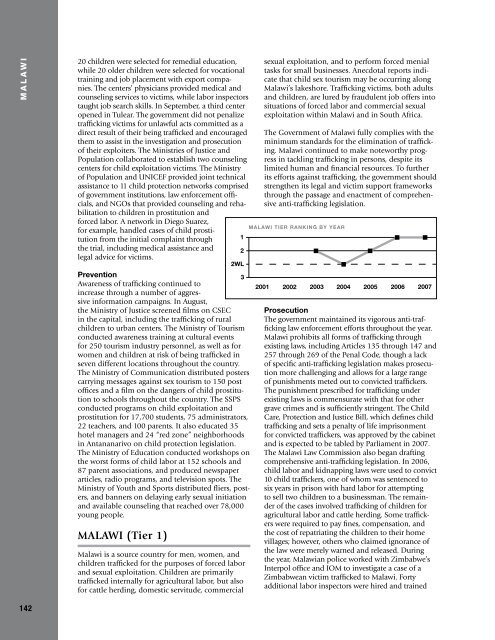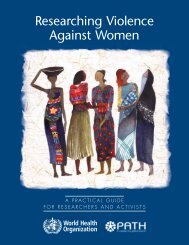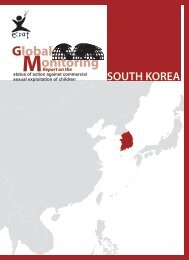2007 Trafficking in Persons Report - Center for Women Policy Studies
2007 Trafficking in Persons Report - Center for Women Policy Studies
2007 Trafficking in Persons Report - Center for Women Policy Studies
Create successful ePaper yourself
Turn your PDF publications into a flip-book with our unique Google optimized e-Paper software.
M A L A W I<br />
142<br />
20 children were selected <strong>for</strong> remedial education,<br />
while 20 older children were selected <strong>for</strong> vocational<br />
tra<strong>in</strong><strong>in</strong>g and job placement with export companies.<br />
The centers’ physicians provided medical and<br />
counsel<strong>in</strong>g services to victims, while labor <strong>in</strong>spectors<br />
taught job search skills. In September, a third center<br />
opened <strong>in</strong> Tulear. The government did not penalize<br />
traffick<strong>in</strong>g victims <strong>for</strong> unlawful acts committed as a<br />
direct result of their be<strong>in</strong>g trafficked and encouraged<br />
them to assist <strong>in</strong> the <strong>in</strong>vestigation and prosecution<br />
of their exploiters. The M<strong>in</strong>istries of Justice and<br />
Population collaborated to establish two counsel<strong>in</strong>g<br />
centers <strong>for</strong> child exploitation victims. The M<strong>in</strong>istry<br />
of Population and UNICEF provided jo<strong>in</strong>t technical<br />
assistance to 11 child protection networks comprised<br />
of government <strong>in</strong>stitutions, law en<strong>for</strong>cement officials,<br />
and NGOs that provided counsel<strong>in</strong>g and rehabilitation<br />
to children <strong>in</strong> prostitution and<br />
<strong>for</strong>ced labor. A network <strong>in</strong> Diego Suarez,<br />
<strong>for</strong> example, handled cases of child prostitution<br />
from the <strong>in</strong>itial compla<strong>in</strong>t through<br />
the trial, <strong>in</strong>clud<strong>in</strong>g medical assistance and<br />
legal advice <strong>for</strong> victims.<br />
Prevention<br />
Awareness of traffick<strong>in</strong>g cont<strong>in</strong>ued to<br />
<strong>in</strong>crease through a number of aggressive<br />
<strong>in</strong><strong>for</strong>mation campaigns. In August,<br />
the M<strong>in</strong>istry of Justice screened films on CSEC<br />
<strong>in</strong> the capital, <strong>in</strong>clud<strong>in</strong>g the traffick<strong>in</strong>g of rural<br />
children to urban centers. The M<strong>in</strong>istry of Tourism<br />
conducted awareness tra<strong>in</strong><strong>in</strong>g at cultural events<br />
<strong>for</strong> 250 tourism <strong>in</strong>dustry personnel, as well as <strong>for</strong><br />
women and children at risk of be<strong>in</strong>g trafficked <strong>in</strong><br />
seven different locations throughout the country.<br />
The M<strong>in</strong>istry of Communication distributed posters<br />
carry<strong>in</strong>g messages aga<strong>in</strong>st sex tourism to 150 post<br />
offices and a film on the dangers of child prostitution<br />
to schools throughout the country. The SSPS<br />
conducted programs on child exploitation and<br />
prostitution <strong>for</strong> 17,700 students, 75 adm<strong>in</strong>istrators,<br />
22 teachers, and 100 parents. It also educated 35<br />
hotel managers and 24 “red zone” neighborhoods<br />
<strong>in</strong> Antananarivo on child protection legislation.<br />
The M<strong>in</strong>istry of Education conducted workshops on<br />
the worst <strong>for</strong>ms of child labor at 152 schools and<br />
87 parent associations, and produced newspaper<br />
articles, radio programs, and television spots. The<br />
M<strong>in</strong>istry of Youth and Sports distributed fliers, posters,<br />
and banners on delay<strong>in</strong>g early sexual <strong>in</strong>itiation<br />
and available counsel<strong>in</strong>g that reached over 78,000<br />
young people.<br />
MALAWI (Tier 1)<br />
Malawi is a source country <strong>for</strong> men, women, and<br />
children trafficked <strong>for</strong> the purposes of <strong>for</strong>ced labor<br />
and sexual exploitation. Children are primarily<br />
trafficked <strong>in</strong>ternally <strong>for</strong> agricultural labor, but also<br />
<strong>for</strong> cattle herd<strong>in</strong>g, domestic servitude, commercial<br />
sexual exploitation, and to per<strong>for</strong>m <strong>for</strong>ced menial<br />
tasks <strong>for</strong> small bus<strong>in</strong>esses. Anecdotal reports <strong>in</strong>dicate<br />
that child sex tourism may be occurr<strong>in</strong>g along<br />
Malawi’s lakeshore. <strong>Traffick<strong>in</strong>g</strong> victims, both adults<br />
and children, are lured by fraudulent job offers <strong>in</strong>to<br />
situations of <strong>for</strong>ced labor and commercial sexual<br />
exploitation with<strong>in</strong> Malawi and <strong>in</strong> South Africa.<br />
The Government of Malawi fully complies with the<br />
m<strong>in</strong>imum standards <strong>for</strong> the elim<strong>in</strong>ation of traffick<strong>in</strong>g.<br />
Malawi cont<strong>in</strong>ued to make noteworthy progress<br />
<strong>in</strong> tackl<strong>in</strong>g traffick<strong>in</strong>g <strong>in</strong> persons, despite its<br />
limited human and f<strong>in</strong>ancial resources. To further<br />
its ef<strong>for</strong>ts aga<strong>in</strong>st traffick<strong>in</strong>g, the government should<br />
strengthen its legal and victim support frameworks<br />
through the passage and enactment of comprehensive<br />
anti-traffick<strong>in</strong>g legislation.<br />
Prosecution<br />
The government ma<strong>in</strong>ta<strong>in</strong>ed its vigorous anti-traffick<strong>in</strong>g<br />
law en<strong>for</strong>cement ef<strong>for</strong>ts throughout the year.<br />
Malawi prohibits all <strong>for</strong>ms of traffick<strong>in</strong>g through<br />
exist<strong>in</strong>g laws, <strong>in</strong>clud<strong>in</strong>g Articles 135 through 147 and<br />
257 through 269 of the Penal Code, though a lack<br />
of specific anti-traffick<strong>in</strong>g legislation makes prosecution<br />
more challeng<strong>in</strong>g and allows <strong>for</strong> a large range<br />
of punishments meted out to convicted traffickers.<br />
The punishment prescribed <strong>for</strong> traffick<strong>in</strong>g under<br />
exist<strong>in</strong>g laws is commensurate with that <strong>for</strong> other<br />
grave crimes and is sufficiently str<strong>in</strong>gent. The Child<br />
Care, Protection and Justice Bill, which def<strong>in</strong>es child<br />
traffick<strong>in</strong>g and sets a penalty of life imprisonment<br />
<strong>for</strong> convicted traffickers, was approved by the cab<strong>in</strong>et<br />
and is expected to be tabled by Parliament <strong>in</strong> <strong>2007</strong>.<br />
The Malawi Law Commission also began draft<strong>in</strong>g<br />
comprehensive anti-traffick<strong>in</strong>g legislation. In 2006,<br />
child labor and kidnapp<strong>in</strong>g laws were used to convict<br />
10 child traffickers, one of whom was sentenced to<br />
six years <strong>in</strong> prison with hard labor <strong>for</strong> attempt<strong>in</strong>g<br />
to sell two children to a bus<strong>in</strong>essman. The rema<strong>in</strong>der<br />
of the cases <strong>in</strong>volved traffick<strong>in</strong>g of children <strong>for</strong><br />
agricultural labor and cattle herd<strong>in</strong>g. Some traffickers<br />
were required to pay f<strong>in</strong>es, compensation, and<br />
the cost of repatriat<strong>in</strong>g the children to their home<br />
villages; however, others who claimed ignorance of<br />
the law were merely warned and released. Dur<strong>in</strong>g<br />
the year, Malawian police worked with Zimbabwe’s<br />
Interpol office and IOM to <strong>in</strong>vestigate a case of a<br />
Zimbabwean victim trafficked to Malawi. Forty<br />
additional labor <strong>in</strong>spectors were hired and tra<strong>in</strong>ed
















